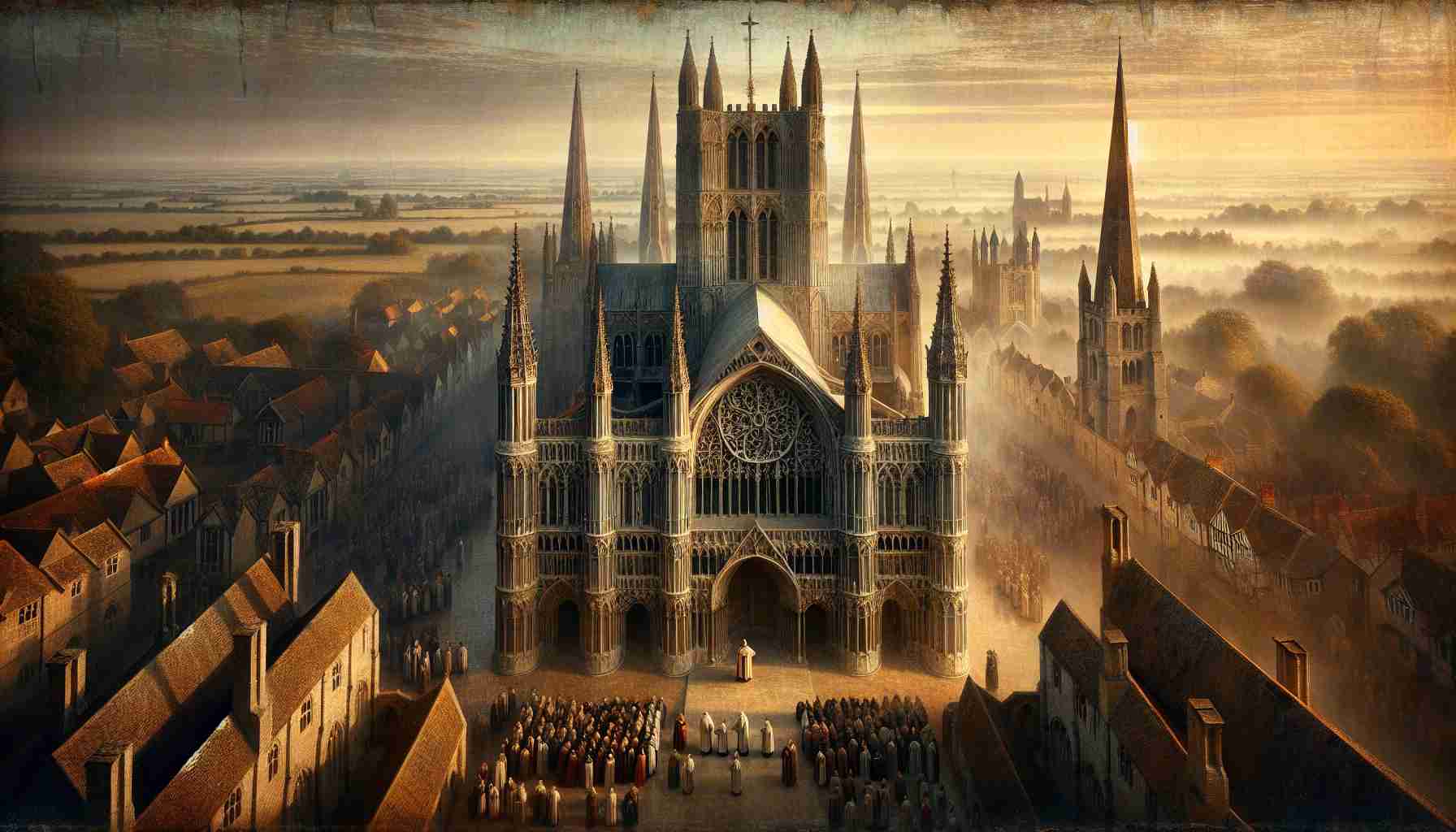

A thin veil of mist clung to the banks of the River Wensum, lifting slowly as dawn spread gold across the East Anglian countryside. Bells rang out in glorious resonance, their peals rising above the flint walls and timber dwellings of Norwich. On this fourth day of June in the year of our Lord 1133, the city stirred not to the cry of market vendors or the clang of blacksmiths’ hammers, but to sacred anticipation: the grand cathedral of Norwich would be consecrated this day.
Stone masons, monks, and noblemen gathered, their hands roughened by toil or softened by silk, all lifting their eyes to behold the cathedral’s newly completed form. Towering above the city, the central spire pierced the heavens—an offering of architecture and devotion. Bishop Herbert de Losinga, weary now with age and burden, stood cloaked in solemn vestments before the western doors. Hidden beneath linen, he carried a relic of the True Cross, placed carefully at the altar beneath the east window: a thread of Calvary tying this cathedral in distant England to the hill where redemption had been won.
Inside, shafts of light lanced through wrinkled glass, illuminating columns fluted like tree trunks in Eden. Overhead, the Norman arches soared with a severity and grace that whispered of both judgment and mercy. Loud sing the choirs, their psalms sending the words of King Solomon into echoing stone: "That thine eyes may be open toward this house night and day, even toward the place of which thou hast said, My name shall be there..." (1 Kings 8:29).
But the journey to this day had been paved with repentance.
Herbert de Losinga had once purchased his bishopric, a stain of simony upon his soul that no vestment could cover. Rome had scorned him for it, and penance had gripped the man ever since. He had built this house not just for the Trinity—but to restore his own name before God. Stone by stone, arch by arch, he labored—constructing what he could not buy: grace.
Outside, the townsfolk spoke in hushed awe. “They say he brings bones from saints,” murmured a weaver’s wife as she held her child close. “And relics of the Passion. A nail, even. To rest beneath the altar.” Rumor danced with faith, and in that mingling, reverence was born.
At noonday, as incense lifted in coils toward the ribs of the nave, the bishop spread his arms before the high altar. The canopy above him, carved with interlacing tracery, caught the sunlight, turning it upon him like a blessing. “In nomine Patris, et Filii, et Spiritus Sancti,” he said, voice trembling. His hands touched oil to stone. The cathedral, decades in the making, was sealed to holiness.
As the crowds flooded through the great doors, past leonine carvings and under arches pregnant with Romanesque rhythm, they became pilgrims in their own city. Young men touched the font carved from black marble, believing baptism in this place would carry the purity of resurrection itself. Women sang into the cloisters, their voices finding an eerie harmony in its curved corridors. Somewhere, a scribe motioned with inky hands over a fresh illuminated page: ecclesia nova consacrata est.
Yet not all hearts were at peace.
In a dim niche behind the apse, a silent monk knelt, his robes threadbare, his face gaunt. He had once been a brother in Canterbury before violent quarrels drove him north. He traced the carved capital of a pillar and wondered whether walls, no matter how hallowed, could cleanse such fury from a soul.
The cathedral was beautiful—undeniably so. But was it the beauty of heaven or the pride of man?
His eyes rose to the ceiling where beasts and saints danced in stone. "O Lord," he whispered, "let this be Thy dwelling, not ours."
Outside, clouds gathered like judgments. A boy clutched his father’s cloak as thunder rolled faintly from the east. But no rain fell. And inside, the cathedral stood immutable—hewn of Caen limestone, its stones imported at great cost across the channel, a glowing ivory against the grey English sky.
The centuries would test this house—fire would claw at its timbered roofs, reformers would strip its altars bare, and war would rattle its stained windows. Yet still it stood, still it called to the weary, the devout, and the doubting, its spine aligned not merely to liturgical east, but to eternity.
And when future generations walked its cloisters, worn smooth by the prayers of a thousand years, they would see in every echo a preacher: not a man, but a stone, declaring Christ risen in curves and columns, arches and light.
Even time itself, unyielding and vast, seemed paused in the presence of such crafted glory.
Thus was Norwich consecrated—not only in grand ritual, but in memory, mystery, and holy stone.